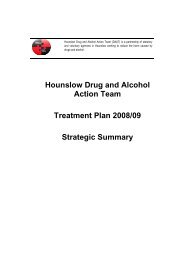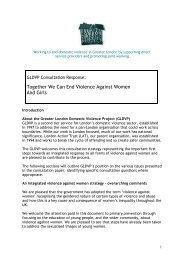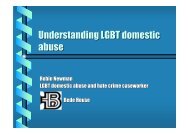1 Domestic violence information
Theory and Practice for the Substance Misuse Sector (pdf - AVA
Theory and Practice for the Substance Misuse Sector (pdf - AVA
Create successful ePaper yourself
Turn your PDF publications into a flip-book with our unique Google optimized e-Paper software.
5. Working with domestic <strong>violence</strong><br />
perpetrators within drug and<br />
alcohol services<br />
In-depth work with perpetrators around their use of <strong>violence</strong> is a<br />
specialist field and holds potential for extreme danger. As such, it<br />
should only be attempted by trained professionals.<br />
The links between domestic <strong>violence</strong> and substance misuse are<br />
controversial, complex and a much under-developed area of debate.<br />
However, given the fact that a perpetrator may not be engaged<br />
with specialist perpetrator services there are things you can do as<br />
substance misuse practitioners to partially address the abuse safely<br />
and effectively. This section focuses on identification of perpetrators,<br />
giving safe messages to clients and referrals to appropriate agencies.<br />
Page<br />
5.1 Facts and statistics 150<br />
5.2 Key messages 151<br />
5.3 Practice issues 155<br />
5.3.1 Routine questioning 155<br />
5.3.2 What to do if your client is perpetrating<br />
domestic <strong>violence</strong> 157<br />
5.3.3 Safety and basic risk assessment 159<br />
5.3.4 Information sharing 162<br />
Why do this work?<br />
Duty of Care/Social Responsibility:<br />
Drug and alcohol workers have a social responsibility to address<br />
all the complex needs of a service user associated with drug and<br />
alcohol use, which may include the perpetration of domestic <strong>violence</strong>.<br />
If the project is working with both partners, there is a duty of care<br />
to ensure the safety and well-being of the service user who is a<br />
victim/survivor of domestic <strong>violence</strong>.<br />
Challenging domestic <strong>violence</strong> could increase the ability to motivate<br />
change in a service user. One of the motivations for change is the<br />
perpetrator’s awareness of the harm they are causing to others.<br />
The actions of workers may help to improve the safety of a victim<br />
of domestic <strong>violence</strong> (including children) and ultimately prevent<br />
serious injury or death.<br />
There is a responsibility to share <strong>information</strong> if a service user is<br />
deemed at risk of harm to others.<br />
Legal responsibilities:<br />
Under section 17 of the Crime and Disorder Act there is a responsibility<br />
to take ‘reasonable’ action to prevent a crime which includes acts of<br />
domestic <strong>violence</strong>. This applies to voluntary sector agencies carrying out<br />
the duties of Responsible Authorities such as PCTs, Local Authority and<br />
the police.<br />
Disclosure of domestic <strong>violence</strong> may result in increased risk for any<br />
children in the household and an effective agency response would<br />
therefore aid in more effective child protection responses.<br />
Any agencies which are funded from the statutory sector have a<br />
positive duty to uphold rights in the Human Rights Act (see pg 211).<br />
5.3.5 Recording <strong>information</strong> 164<br />
5.3.6 Referrals to perpetrator programmes 164<br />
148<br />
© Stella Project Section 3 - <strong>Domestic</strong> Violence<br />
© Stella Project Section 3 - <strong>Domestic</strong> Violence 149












